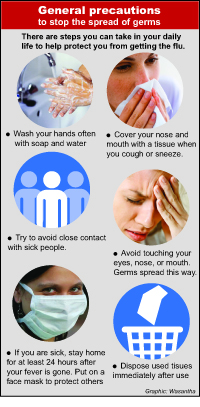News
Take basic precautions, say health officials as seasonal flu spreads
Don’t panic but take basic precautions against ‘seasonal flu’, stressed top health officials, as Influenza A/H1N1 spread rapidly in neighbouring India.
Dispelling concerns about the spread of so-called ‘deadly’ swine flu, Chief Epidemiologist Dr. Paba Palihawadana was quick to point out that what was spreading in India was Influenza A/H1N1 and swine flu was a misnomer. (See box)
Pointing out that usually there could be deaths from such seasonal flu when it affects vulnerable groups such as expectant women, the very young or the very old, Dr. Palihawadana said that those with co-morbidities (other illnesses) such as cancer and diabetes could also be more affected.
In Sri Lanka, the more common is Influenza A/H3N2, she said, adding that there usually are a few cases of A/H1N1.
“We are on alert for any changes in the influenza patterns. There is good surveillance, with strong testing by the Medical Research Institute. We also have the necessary stocks of anti-viral medication. Sri Lanka is ready since we put in place pandemic preparedness measures in the late 2000s,” she said.
Dr. Palihawadana’s advice is that people should avoid crowds if they are ill and if they have returned from abroad and develop symptoms of the flu, they need to seek medical attention.

Dr. Paba Palihawadana
A World Health Organisation (WHO) source, meanwhile, also reiterated that Influenza A/H1N1 was a seasonal flu. It is not swine flu (pigs infecting humans) but spreads from human-to-human. During the winter months there could be minor epidemics of this flu.
Giving the officially reported figures in India from January 1 to February 22, 2015, as 14,673 cases and 841 deaths, the source conceded that the case fatality in India is a little high due to those with co-morbidities succumbing to the illness. Influenza A/H1N1 is predominantly in northern India but has also affected some in the south.
With regard to the situation in Sri Lanka, the source said that while surveillance data indicate the predominance of Influenza A/H3N2, there usually are a few cases of A/H1N1 as well.
Urging those with colds and coughs to avoid crowded places and monitor their illness closely, the source advised those travelling outside the country to take the usual precautions to avoid catching the flu.
The source recalled that after the ‘pandemic imminent’ signal back in 2009 for Influenza A/H1N1, it was later downgraded. But the WHO did warn that it would be around for a few years as a seasonal flu. When it first came as a pandemic signal, it was thought to be linked to pigs and that is how the swine-flu misnomer came about.
Swine flu is in general, a highly contagious respiratory disease of pigs caused by one of several swine influenza viruses (SIVs), according to the WHO website.
It adds that SIVs do not normally infect humans. However, outbreaks and sporadic human infection with SIVs have been occasionally reported. Most commonly, infection occurs in people in direct contact with pigs such as farm and abattoir workers.
The six phases of Influenza A/H1N1.
Influenza A/H1N1 which sent the world into pandemic mode back in 2009 was later declared a ‘seasonal flu’, the Sunday Times learns.
Back then (in 2009) the WHO declared a ‘public health emergency of international concern’ and raised the pandemic alert level of Influenza A/H1N1 firstly from Phase 3 to 4 and then to Phase 5.
The WHO has a pandemic scale of 1 to 6, with 3 being sporadic cases in humans but with no significant human-to-human transmission; 4 being human-to-human transmission causing community-level outbreaks; and 5 being that a pandemic is imminent. Phase 5 is also when there is human-to-human transmission of a deadly virus into at least two countries in a WHO region.
Phase 6 is the red alert that a pandemic is underway with the deadly virus spreading to another country in a different WHO region.

